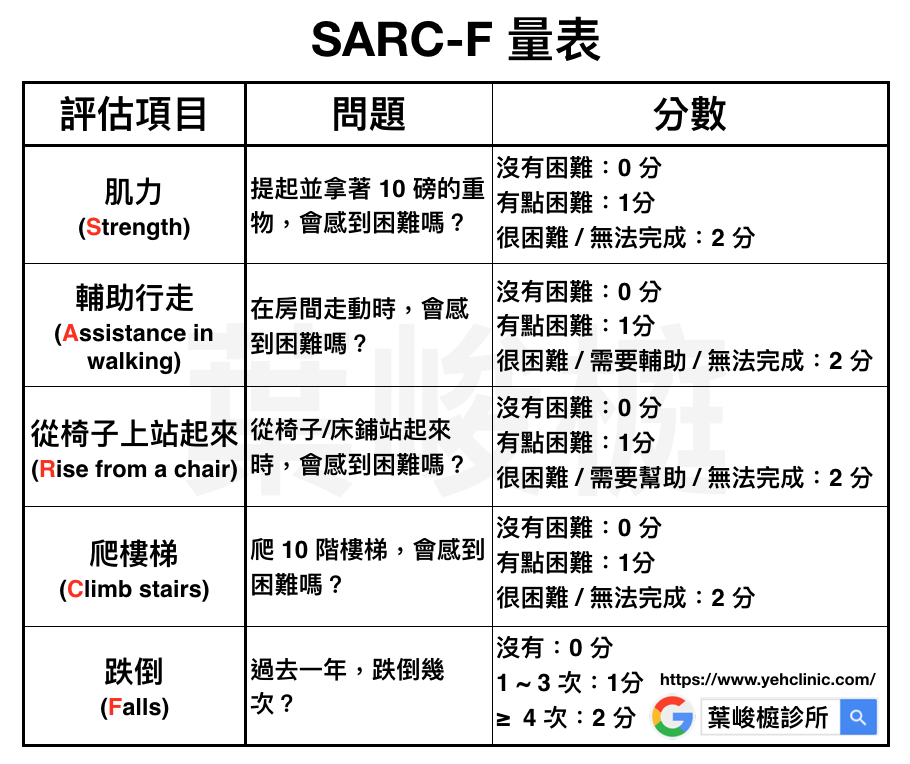《肌少症》肌少症老年人的臨床實踐指南 👴
✨原文出處 🔜https://www.yehclinic.com/clinical-practice-guidelines-for-older-people-with-sarcopenia/
台灣逐漸步入老年化社會,肌少症是一個無法忽視的問題。患有肌少症的老年人,會有肌力減弱、肌肉質量下降、體能表現衰退等問題。針對肌少症,肌少症和脆弱性研究國際會議工作組 (the task force of the International Conference on Sarcopenia and Frailty Research, ICSFR),發表了臨床實踐指南。
✨延伸閱讀:🏅️奧運獎牌的啟示 🔜 被忽視的肌少症 💪
✨延伸閱讀:老化過程,體內賀爾蒙會怎麼變化?

☑️篩檢 (Screening)
1⃣️65歲以上老年人,應每年篩檢肌少症 ; 或是在發生重大健康問題後,進行篩檢。
1A. Older adults aged 65 years and older should be screened for sarcopenia annually, or after the occurrence of major health events.
2⃣️可以使用步態速度 (gait speed),或使用 SARC-F 問卷,來進行肌少症篩檢。
1B. Screening for sarcopenia can be performed using gait speed, or with the SARC-F questionnaire.
3⃣️篩查為陽性,應轉診至專業醫療人員,進一步評估,來確認是否有肌少症。
1C. Individuals screened as positive for sarcopenia should be referred for further assessment to confirm the presence of the disease.

☑️診斷 (Diagnosis)

1⃣️建議健康管理人員,使用客觀的測量工具,來診斷肌少症,並參考相關的共識指引。
2A. It is recommended that health practitioners use an objective measurement tool for the diagnosis of Sarcopenia, utilising any of the published consensus definitions.
2⃣️診斷肌少症時,可以安排 DXA 檢查,評估肌肉量減少程度。
2B. DXA should be used to determine low lean mass when diagnosing sarcopenia.
3⃣️診斷肌少症時,應使用『行走速度』或『握力』,來確定肌力 (muscle strength) 、身體表現 (physical performance) 等,衰退的程度。
2C. Walking speed or grip strength should be used to determine low levels of muscle strength and physical performance respectively when diagnosing sarcopenia.
✨延伸閱讀:💪怎樣才算人中之龍(鳳)❓

☑️身體活動 (Physical Activity)
針對肌少症患者,開立阻力/重量訓練為主的運動處方,可以改善肌肉質量 (lean mass)、肌力 (strength)、身體活動能力 (physical function)。
3A. In patients with sarcopenia, prescription of resistance-based training may be effective to improve lean mass, strength and physical function.
✨延伸閱讀:《運動》抗老化/促進健康 🔜肌力訓練不可或缺❗️ 『怪獸訓練』動作學習流程圖
☑️蛋白質 (Protein)
1⃣️建議臨床醫療人員,考慮對患有肌少症的老年人,進行蛋白質補充/富含蛋白質的飲食。
4A. We recommend clinicians consider protein supplementation/a protein-rich diet for older adults with sarcopenia.
2⃣️臨床醫療人員,可以與患者討論『足夠卡路里和蛋白質攝取量』的重要性。
4B. Clinicians may also consider discussing with patients the importance of adequate calorie and protein intake.
3⃣️足夠的營養 (蛋白質) 攝取,也要搭配適當的身體活動。
4C. Nutritional (protein) intervention should be combined with a physical activity intervention.
☑️維生素D (Vitamin D)
目前沒有足夠的證據,來證實維生素D的補充,對於患有肌少症的老年人是否有效。
5A. Insufficient evidence exists to determine whether a Vitamin D supplementation regime by itself is effective in older adults with sarcopenia.
☑️合成代謝賀爾蒙 (Anabolic Hormones)
因為目前的證據有限,並不足以推薦『使用合成代謝賀爾蒙,來治療肌少症』。
6A. The current evidence is insufficient to recommend anabolic hormones for the management of sarcopenia.
✨延伸閱讀:《內分泌》想變成美國隊長嗎?淺談選擇性雄性素受體調節劑 (Selective androgen receptor modulator, SARM)
☑️藥物 (Pharmacologic Interventions)
不推薦使用藥物,來作為肌少症的第一線治療。
7A. Pharmacological interventions are not recommended as first-line therapy for the management of sarcopenia.
✨延伸閱讀:💉使用睪固酮增加體能!代價卻是….?
☑️研究 (Research)
在未來,針對患有肌少症的老年人,該如何治療,還需要有更多相關的研究。
8A.. Future international collaboration and large-scale RCTs focusing specifically on older people with sarcopenia are recommended.
總結
針對患有肌少症的老年人,ICSFR 工作組的臨床實踐指南,建議我們開立『阻力/重量訓練為主』的運動處方,來改善肌肉流失、肌力、身體活動能力。
這份臨床實踐指南中也提到,(有條件地)推薦肌少症老年人,多補充蛋白質。此外,目前仍不推薦常規補充維生素D或使用合成代謝賀爾蒙。
作者:葉峻榳醫師 (新陳代謝專科, 美國運動醫學會大中華區講師, 歐格瑪健身中心醫療顧問,仁寶電腦專案顧問)
參考資料 🔜 International Clinical Practice Guidelines for Sarcopenia (ICFSR)- Screening, Diagnosis and Management. J Nutr Health Aging. 2018;22(10):1148-1161.
